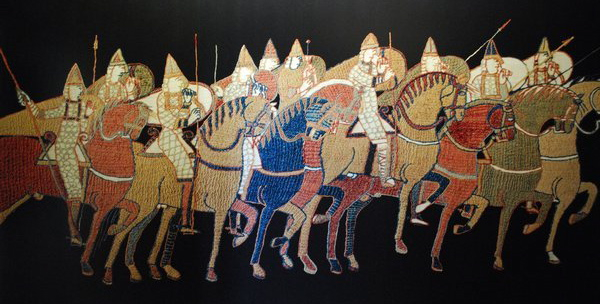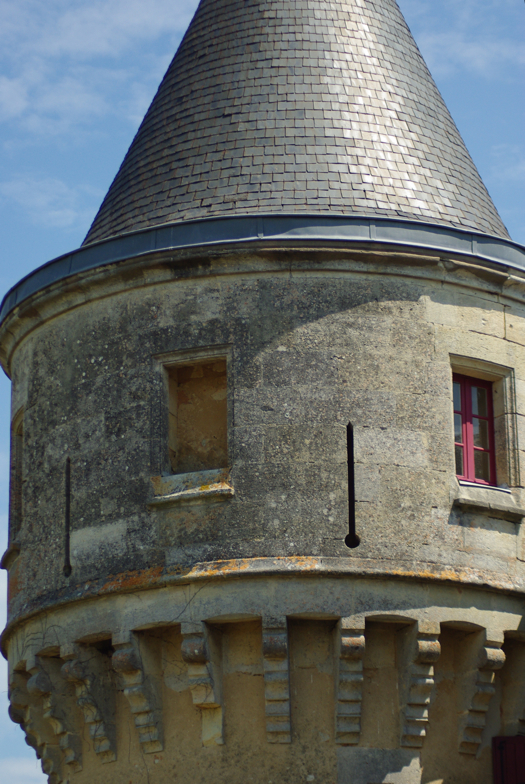
Those of you who read my comments on the first few chapters of Carola Hicks's awkwardly-titled The Bayeux Tapestry: The Life Story of a Masterpiece, are probably wondering whether I was ever able to get over my yearning for a close reading of the Tapestry, and enjoy this book for what it is: a "biographical" account following the artifact through the thousand years since its composition, and all of the social and ideological battles that have been fought over and around it during that time. And the answer would be, more or less, yes. I'm still interested in reading something geared more toward artistic analysis of the Tapestry—something that "fondles its details," as Nabokov might say—but Hicks's approach proved quite juicy as well, and brought up some interesting points of consideration.
She has plenty of material to work with. The Bayeux Tapestry has simply been around longer than most non-classical works of art in the Western canon, and when you combine that with the fact that by its very nature it exists on the boundary between two nations—depicting as it does the invasion of England by the Normans, a people from what is now the northwest corner of France—it's not surprising that the work has become the site of a number of nationalistic and ideological struggles throughout the years. As "antiquarianism" (the 17th and 18th-century precursor to anthropology) gained ground, for example, the Tapestry was the subject of a hilarious series of sniping pamphlets between Frenchmen and Englishmen, who argued bitterly about whether the thing was a "French" or an "English" artifact. The fact that the modern "English" have long incorporated Norman heritage into their identities; that "Normans" were not exactly French to begin with; and that the Tapestry's own narrative is remarkably sympathetic to those on both sides of the Conquest; did not stop pamphleteering gentlemen of leisure from interpreting the embroidery in the most jingoistic terms, such as in this nuanced reading from 1742:
We see the faithless, inconstant and perfidious disposition of the French and their behavior towards us. We see, then as now, the genius of the English, brave, generous, honest and true. We may learn hence never to trust the bonne foy of that nation, but expect they will still be the same, as from the beginning.
The question addressed in my previous posts, about who did the actual embroidering on the Tapestry, was actually a topic of hot debate during this time. The French contingent attempted to emphasize the work's Frenchness by claiming that it was embroidered by the French queen Mathilde (wife of William the Conqueror), whereas the English contingent tried to emphasize the opposite by claiming that it was embroidered by English monks or nuns, on English soil. As far as I can tell, this debate is still very much alive, with no one definitive interpretation emerging—although the theory that it was commissioned by Odo, designed by a monk and executed in England seems to be the most popular.
For their side, the French used the Tapestry when convenient to serve as a model for current events. Napoleon, for example, had his arts-and-culture man Denon arrange an exhibition of the Tapestry in the newly-converted Louvre, in order to drum up popular support for the idea of a Napoleon-led invasion of England. He even went so far as to plant pieces of information in the press (which he controlled) to the effect that a comet had recently been seen in the skies—just like the one in the Tapestry that heralds the downfall of Harold and the arrival of William the Conqueror. Clearly, whatever Napoleon wanted to do must be sanctioned by divine right.
In a similar but slightly stranger vein, Heinrich Himmler and the Nazi party were extremely interested in the Tapestry during the Second World War. As far as the Nazis were concerned, the Anglo-Saxon heritage of the pre-Conquest English made them more or less Vikings, which meant that they were more or less German. (I'm betting they did not ask a Norwegian's opinion on this.) Which, in turn, meant that the Bayeux Tapestry could be "reclaimed" as an example of "pure Aryan" art, and removed back to Germany to serve the cause of Nazi propaganda. It was only through the resistance of a few individuals (both German and French), and a series of lucky breaks, that the artwork survived the War and remained in France. This Nazi angle is one of the stories that Hicks is very interested in telling: she opens the book with an anecdote about Himmler ordering the Tapestry removed to Berlin in the last days of the War, and her chapters on WWII are longer and more detailed than most others. Personally, I found that they dragged a bit, but I must admit to being a little "Nazi-ed out" in my reading, so others may feel differently. Not, of course, that Nazis and the Holocaust should not be written and talked about, but I've read a LOT about them and at this point am more interested in other historical periods.
One of the aspects of the book I did find reliably fascinating was Hicks's examination of the social debates taking place around the tapestry: in particular, its relationship to feminism and art theory. In the early Victorian era, when the first rumblings of an organized feminism were afoot, attitudes to embroidery within that nascent movement were very conflicted. For some early feminists, like Mary Wollstonecraft and Mary Lamb, embroidery was pointless, infantilizing busy-work, taught to upper- and middle-class women in order to signify that they had nothing important to do and so could afford to waste their time on trifles. These women agitated for a female education closer to that received by boys, emphasizing physical and mental activity over sedentary domestic arts. A different contingent of early feminists, however, looked to the Bayeux Tapestry and other works of needle art as a uniquely female sphere of artistic endeavor—one often unfairly dismissed, yet in truth equal to the male-dominated mediums of painting and sculpture, and in need of rehabilitation in the public eye. Both of these arguments are fascinating, and remarkably similar to debates still raging among feminists in the fiber arts world today. Neither side presents a case I can wholeheartedly agree with, but both provide food for thought, particularly as they intersect with issues of class. (And just to add spice to the mix, still other Victorian critics claimed that the naked figures in the margins of the Tapestry proved it COULDN'T have been embroidered by women, as their native delicacy would never have permitted such lewd subject matter.)
The other unexpectedly thought-provoking thread in Hicks's book was her tracing of aesthetic reactions to the Tapestry through time. In the 18th and 19th centuries, for example, most people were extremely put off by details that I would not even think to criticize: for example, that the colors in the Tapestry are not "true to life," or that a single horse is often portrayed using different colors. See below, for example; the inner side of a horse's back leg is often embroidered in a different color, giving a sense of depth without Renaissance-style perspective.
Similarly, 18th and 19th-century viewers were alienated by the lack of classicism in the style of the Tapestry. They equated "good art" with the ideals of Greek and Roman statuary and the painting that imitated it—illusionistic perspective, clothes that drape "realistically" over a muscled body, and so on—and in many peoples' minds there simply was no other yardstick by which to measure a piece of art. Accordingly, when people started attempting to revive the reputation of the Bayeux Tapestry, they made obsessive parallels to classical art; the only way they could think to elevate public opinion of the Tapestry was to uncover previously-unnoticed similarities to the Greek and Roman style. Only the most sensitive art critics of these times, among them John Ruskin, were able to evaluate the Tapestry on its own merits rather than attempting to imagine it into being as the Roman frieze it so plainly is not. It's fascinating to think that modern viewers, long accustomed to the playful abandonment of perspective pioneered by Van Gogh and others, and the anti-realistic use of color in everything from Picasso paintings to TV commercials, can more easily appreciate the artwork of the Tapestry than people for several centuries before us.
So, despite the occasional slow section, Hicks's Bayeux Tapestry was more than worth my time. I have another, lavishly illustrated book of academic papers on the Tapestry, so hopefully I'll get my fill of both its biographical and textual details.








